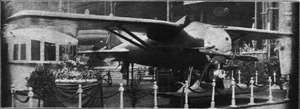Nieuport-Delage NiD 37
| NiD 37 | |
|---|---|
 | |
| Nieuport-Deage NiD.37 fighter at the 1922 Paris Show | |
| Role | Single-seat fighter |
| National origin | France |
| Manufacturer | Nieuport-Delage |
| Designer | E. Dieudonné |
| First flight | April 1923 |
| Number built | 1 |
|
| |

The Nieuport-Delage NiD 37 was a single-engine, single-seat monoplane fighter aircraft and racer designed and built in France in the early 1920s. It had a small foreplane to bring the centre of pressure forward. Heavy, slower than expected and with turbo-supercharger problems, it was not developed.
Design and development
Though the NiD 37 has sometimes been termed a sesquiplane,[1] it is better described as a shoulder-wing monoplane with a small foreplane. Its immediate predecessor was the NiD 31, which had a similar layout though its foreplane was much less far forward than that of the NiD 37. The two also differed in detail throughout, notably in wing plan and bracing, cockpit position and engine.[2]
The fuselage of the NiD 37 was constructed in Nieuport-Delage's usual way, a monocoque shell of spirally wound tulipwood glued together and with a final outer fabric covering. This gave a smooth finish to the circular cross section structure which tapered gently to the tail but had a rather abrupt, dome-shaped nose housing the 224 kW (300 hp) Hispano-Suiza 8Fb water-cooled V-8 engine and its Rateau turbo-supercharger. The engine was mounted with its output shaft low down in the nose and drove a two-blade propeller. Though this was of the wooden, fixed-pitch type, it was intended that it would be replaced by a variable-pitch Lavasseur airscrew later. A single, roughly cylindrical Lamblin radiator was suspended below the engine, between the undercarriage legs.[1][2]
Dieudonné, the designer of the NiD 37, paid particular attention to the pilot's field of view, and the open cockpit, with screen and faired headrest, was placed well forward, immediately behind the engine. To improve the his view downward, the leading edges of the main wing, which outboard were straight and unswept, were curved sharply in towards the root, meeting the fuselage just behind the pilot's head. He could thus look vertically down between this edge and the trailing edge of the foreplane, aligned with the leading edge of the outer sections of the mainplane and mounted well below on the undercarriage struts. Apart from long, curved tips, this foreplane had straight edges and constant chord; it had a span of about 40% that of the mainplane and less than 20% of its area. Its function was largely to bring the centre of pressure forward. The main wing was slightly tapered away from its roots and with square tips. It was built around four spars and covered in stressed 3-ply, with long-span ailerons but no flaps. On each side a V-form pair of tubular struts within aerofoil fairings braced the lower fuselage to the wing.[1][2]
The trailing edge of the mainplane had a long fillet reaching almost to the curved leading edge of the broad tailplane; mounted at mid-fuselage, this had strong inboard sweep, decreasing outwards. It carried horn-balanced elevators. The fin was smaller, with a rounded, balanced rudder. The NiD 37 had a fixed, conventional undercarriage with its mainwheels, streamlined with partial (45°) aluminium fairings, mounted on faired V-struts. These had short forward projections to carry the foreplane at axle height.[1][2]
The NiD 37 first appeared in public at the Paris Air Show in December 1922, though it had not then flown. It carried twin 7.7 mm (0.303 in) Vickers machine guns mounted in the nose immediately in front of the cockpit and over the engine. Its first flight was in the following April. Further tests proved disappointing; the NiD 37 was heavy compared with its competitors and slower than expected, never achieving the predicted 250 km/h (155 mph) top speed. There were also problems with the turbo-supercharger because of the limitations of the high-temperature alloys of the time. For these reasons the development programme was ended.[2]
Specifications
Data from Green and Swanborough[2]
General characteristics
- Crew: One
- Length: 7.16 m (23 ft 6 in)
- Wingspan: 11.80 m (38 ft 9 in)
- Height: 2.97 m (9 ft 9 in)
- Wing area: 26.80 m2 (288.5 sq ft) total; upper wing 21.78 m² (234.5 sq ft)
- Empty weight: 980 kg (2,161 lb)
- Gross weight: 1,420 kg (3,131 lb)
- Fuel capacity: 240 L (53 Imp gal; 63 US gal)
- Powerplant: 1 × Hispano-Suiza 8Fb upright water cooled V-8, 220 kW (300 hp)
- Propellers: 2-bladed fixed pitch
Performance
- Maximum speed: 250 km/h (155 mph; 135 kn) at 7,000 m (22,965 ft) estimated but optimistic
- Wing loading: 53 kg/m2 (10.8 lb/sq ft) including both planes[1]
- Power/mass: 0.16 kW/kg (0.095 hp/lb)[1]
Armament
- 2 × 7.7 mm (0.303 in) Vickers machine guns fixed in nose
References
| Wikimedia Commons has media related to Nieuport. |